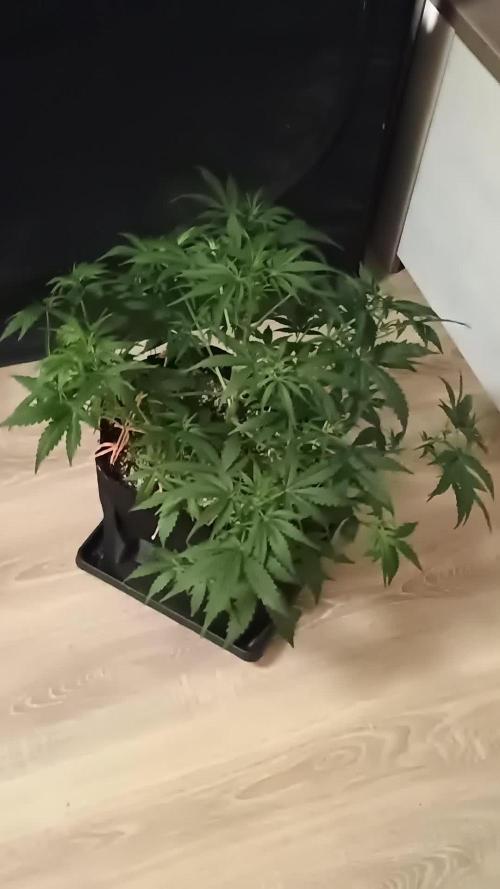The Grow Awards 2026 🏆 























Likes
23
Share


@eldruida_lamota
Follow
Ya en la recta final familia, están apuntito, solo unos días más.
Nuestras lemon kush ya recibieron su lavado de raíces , están sin productos ya solo AGUA.
Controlamos de todas formas el Ph igual y que no baje por debajo de 6,2.
Bestiales estás flores , un olor muy característico con tonalidades cítricas que recuerdan al limón.
Todo un clásico en verdad.
Estos ejemplares carecen de brazos laterales, son óptimas para un SOG desde semilla, pudiendo llenar 16 plantas en metro cuadrado.
Likes
26
Share


@BrMarijuana
Follow
Devido a Rega a cada dois dias, resolvi fracionar a dosagem semanal de fertilização para toda Rega, sendo assim, rego a cada dois dias da semana, totalizando três regas semanais, com isso fraciono a dosagem para 2ml líquido e 0,16g de mineral a cada litro d'água, totalizando 6ml líquido e 0,50g de mineral por semana.
Likes
1
Share


@BiggaB
Follow
Plant freshly cropped smells very gassy, big trichomes
I will post the harvest once dried✌️
Likes
23
Share


@Targona
Follow
29 days since my seed sprouted a little girl🌱
The fourth week of growing my Space Cookies Auto 🌠🍪🚀
Nutrients:Nutrients - transition to flower:
Plagron Alga Bloom is an organic flower fertilizer for growing in soil. The fertilizer is algae-based and contains amino acids, proteins and a balanced ratio of phosphorus and potassium 🌺
------------------------------------------------------------------------------------
Plagron Green Sensation is a flower booster. Green Sensation is a 4-in-1 product, so you don't need to add additional fertilizers. Suitable for all types of substrates and systems 💚💜💚
------------------------------------------------------------------------------------------------------------------
Bud Candy is a carbohydrate supplement from Advanced Nutrients that maximizes the growth and aroma of flowers. It supports strong root activity by providing food for beneficial microorganisms.
------------------------------------------------------------------------------------------------------------------
BioBizz Calmag is a 100% organic, but also vegan fertilizer with BIO certification. Biobizz Calmag was designed for professional growers and home growers who need an extra dose of calcium and magnesium. It contains added humic acid 💩☘️- I only apply it once a week.---------------------------------------------
Biobizz Bio pH-/ Biobizz Bio pH+ is a 100% natural and vegan pH regulator. Suitable for all types of substrates and crops. For use in growth and flowering. 💩🍋🌱
----------------------------------------------------
PRO-MIX CONNECT MYCORRHIZAL POWDER - for substrate
Generally:
Space Cookies Auto 🌠🍪🚀 is the only one that grows
in the PRO-MIX HP Mycorhize+Bacillus substrate, where I also add coconut fiber and perlite ☘️🌱
The girl is already fully blooming 🌺🏵️, it is a plant with many branches, it grows more broadly, like a bush than like a Christmas tree. That is why it is quite demanding to train, the branches are not very strong, so I have to handle it carefully. I have to do LST and defoliation very often - the plant breathes much better then 🍃🍃
I use the new pH and EC meter Aqua Master Tools P110 PRO, the measurement is fast and accurate 👌 So far I have managed to keep the pH and EC as they should be. Although my EC has jumped a little more now, I diluted the watering so that the EC drops. I use Biobizz Bio +/- to correct it. The excellent mycorrhizal powder PRO-MIX Connect to support the roots certainly works very well. All the girls are very strong and stable from an early age 💚🌿🌲
Training:
As I mentioned above, this week I had to do LST and defoliation 2 times. The branches are delicate, but there are really a lot of them. I made the first defoliation bigger, the second one more gentle 🍃
Likes
51
Share


@Bones_1986
Follow
Looking like i have a magnesium deficiency as show in the leaf pic.
I'm Gonna increase the cal-mag.
Day 37 : Pots were dry so fed 2.5 liners to the 5 gallon pot and 1.5 liters to the 3 gallon.
Upped the cal-mag.
Introduced Big Bud & PK Boost
Likes
9
Share


@Milkogollos
Follow
En esta 3ra semana le corte los primeros 4 brotes a cada planta, ya que considero que esos primeros brotes quedan tapados por la luz y no se desarrollan tanto.
Han crecido de buena manera, aunque el color verde de las hojas no es pareja, quizás la poda les afectó un poco o porque la extracción sigue siendo pasiva para mantener la humedad y eso afecta al proceso metabolico.
Durante la próxima semana el fertilizante de root-juice lo cambiaré por vitamax pro, y mejorare la entrada y salida de aire.
.... Se me había olvidado agregar a la solución de agua de bidon Cal-max, tal vez eso les faltaba, lo tendré en cuenta.
Likes
11
Share


@Andres
Follow
she is growing healthy ... in her fourth week ... outdoors she has grown in form ... moderately ... and just waiting for her to show her great potential.......
Likes
2
Share


@Yiyis_Grow
Follow
Lámpara: Bestva Quantum Board LED LM301B
Sustrato: 2 Jiffy fino : 1 Floragard
Especies: Charlotte Dream CBD - Auto Dark Purple - Purple Kush - Triping 25 - Gelato Ice
Acontecimientos:
1. Se empezaron a suministrar fertilizantes a 5 de ellas, las otras 5 van un poco retrasadas.
2. Se puso tierra diatomea en el sustrato para evitar así plagas. En casa hay muchas plantas y las plagas abundan.
3. Luz 20h/día, viento, agua y nutrientes.
Buenos humos
Likes
10
Share


@I_roll_my_own_420
Follow
Hey growers! Another week finished today. I used cannaflush this week and will use just ph correct clean water next week before harvest. Hulkberry is a sticky beast! Tonnes of crystals on them! Amazing smell. Orange sherbert shows its indica dominance and smells like orange tic-tac 😁. Cant wait to cut them down. Lights will turn off in 6 days and plants will stay in dark last 48h before cutting them down. Cheers!
Likes
4
Share


@xANICx
Follow
“Everything is going great, but my big problem now is that all three plants are in different stages—one of them feels like it’s three weeks ahead of the others. But apart from that, everything is perfect and I’m very satisfied so far. I think for my next grow, I’ll switch to photoperiod plants, since I can control them a bit more than autoflowers. But for my second grow ever, I’m already really happy with how it’s going.”
Likes
224
Share


@Hellishjam
Follow
Ladies are on beast mode! Friday they got 4 cups of 4-4-4 Gaia green and 8gal of compost tea. I did some super cropping as there getting pretty tall and I don’t want them over the fence and at this rate there going to be! Hopefully if everything goes as planned I’ll have the boards or at least some to put up the next time I come home. We’re now into the 10 foot in diameter cages, a few branches started poking thru just the other day. These girls are going to be bigger then last year that’s for sure there already way bigger. We’ll see what next week looks like after some hst thanks for stoppin in.
Likes
9
Share


@TheWeedaltor
Follow
She stretched much because no space, hope to adjust her when I will chop the first Wedding cake.
Removed just some big fan leaves

































